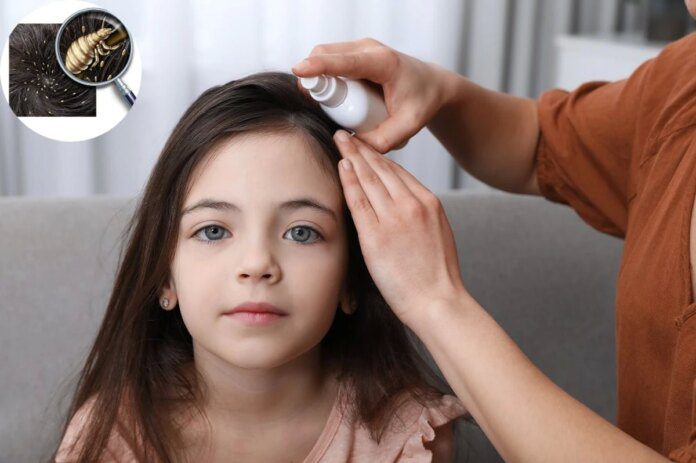Lice infestation is one of the most embarrassing and annoying problems your child can face. Fortunately, there are effective and handy solutions that make this embarrassing experience quickly forgotten.

After the pandemic restrictions, the “season” of pediculosis (the scientific name for lice infestation) has reopened. And that’s because, since the beginning of the world, communities of children have been the favorite target of these ugly insects, which cause itching on the scalp, but also a marginalization from the others, who are careful not to be infested in their turn.
An old problem since the world
Did you know that the problem of lice has existed since ancient times? And not only among children, but also among adults. This was also the reason for the appearance of the first wigs, five millennia ago. It is curious that this hair accessory appeared almost simultaneously in several areas of the world: Egypt, Sumer, Assyria and Persia, i.e. in warm areas. Initially, the role of the wig was to protect the wearer from lice. A fierce necessity, it seems, especially among the ancient Egyptians, who used very well-studied and arranged wigs, under which, in many cases, they had shaved scalps. Researchers from Great Britain even discovered, in the sand of the city of Hierankopulos, the oldest louse and the oldest wig made by Egyptian hairdressers, the samples dating back to 3500 BC.
In the modern world, lice continue to wreak havoc. As a miscellaneous fact, the Americans calculated that, at the level of the 90s, 367 million dollars were spent for the management of this pathology in children, including the costs for treatments, the losses recorded by schools and parents, due to their absence from service. More recently, it has been estimated that more than $1 billion has been spent annually worldwide to treat pediculosis.
What lice look like
These wingless insects are about the size of a sesame seed (two to three mm), have six legs, and are usually tan to grayish-white in color. The female lives for three to four weeks and can lay up to 10 tiny eggs, called lindis, every day. They are fixed firmly at the base of the hair, with a sticky substance produced by the louse – that’s why they are hard to detach. Empty eggshells are easier to see because they appear white on darker hair. The eggs hatch in eight to nine days, when a nymph leaves the shell, and after another 9-12 days it becomes an adult. A cycle that repeats itself every three weeks!
Lice feed by injecting small amounts of saliva into the scalp, which allows them to suck small amounts of blood every few hours. The itching or itching experienced by the wearers is caused by sensitization of the scalp to the components of the saliva. Often, excoriations can also be visible on the back of the neck, the neck and the skin behind the ears – that is, the favorite places for lice to catch, which, in order to develop, need warmth and moisture.
How the infestation occurs
Small parasites spread easily among children between the ages of three and 14. And, despite the general opinion, it is NOT a problem of personal hygiene (as one in five Romanians still thinks), they even prefer a clean environment. At the same time, lice do not jump, do not fly (because they do not have wings!) and are not transmitted through pets. In most cases, the transmission of pediculosis occurs through direct contact, when the little ones play and sit very close to each other or borrow their hats, caps, headbands, etc. The places and situations where children can contact lice are surprisingly many and varied (parks, playgrounds, camps, children’s clubs), but the most common are kindergartens and schools.
However, there are studies that show that lice do not stay on a brush, comb or hat, needing a temperature similar to that of the human body, and on surfaces such as pillowcases they only last about 4%.
Did you know that after a month, the female is able to lay up to 400 eggs?
What are the remedies?
Ancient Asian civilizations used Neem extract for its anti-parasitic, antibacterial and insect-repellent properties. Its uniqueness lies in the action it has only on insects, not in the case of warm-blooded beings. Neem extract has an immediate effect, acting within the first few minutes of application and killing not only lice but also nits.
Although there are still people who still use the invasive gas or remedies such as salt vinegar, in the modern era, we have specialized treatments, in the form of shampoo or spray, which can be bought in pharmacies. They do not attack the scalp or the hair root, although they kill 99.9% of lice. At the same time, combing with a comb with fine teeth (spaced at a distance of 0.2 mm) removes both parasites and their eggs.
It should be known that lice survive less than a day away from the scalp, and their eggs cannot hatch at lower temperatures than those near the scalp. However, it is recommended to wash the clothes and linen used by the infected person at a minimum of 60 degrees.
This is how we manage shame!
Despite the quick solutions to eradicate pediculosis, there is still a lot of stigmatization, reaching the point of removing children from schools, avoiding them by friends or excluding them from various events. Pediculosis has nothing to do with social status, nor with living in the village or in the city. At the same time, a very short haircut or even a head shave, as radical methods of eliminating the infestation, only accentuate the psychological effects on the child, who is so anxious about what is happening to him.
@shutterstock




































